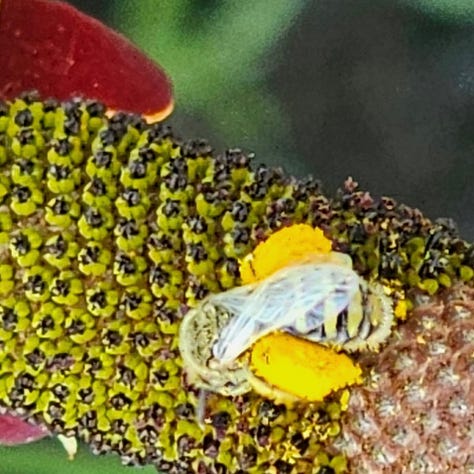


There are moments when I realize how truly fortunate I am.
Somehow, with everything that was (always) going on in our family, I managed to raise two boys who see things deeply. They grew up to be avid museum goers, appreciators of art, and noticers of natural wonder.
One of those boys is gone now and I miss him. The other boy — now a young man — is still here, and he still amazes me with his noticing.
The other morning, he and I arrived at the BioPark, Albuquerque’s superb botanical garden, just as it was opening. There were no crowds — only a delightful breeze and plenty of shade.
We carry a lot of memories on our visits to these carefully tended gardens. A BioPark summer concert, complete with a two-cooler picnic, was always part of our annual trip to see the grandparents. At some point, the boys were old enough (and reliable enough) to run from the big lawn — and the boring grown-ups — to watch the not-too-distant toy train exhibit, where realistic freight trains chugged past small town dioramas, and elderly steam engines pulled flatbed cars sometimes loaded with dinosaurs.
In the walled Ceremonial Garden — where wisteria, clematis, and climbing roses form a gorgeous canopy — we recall a long-ago magic show, when my son was, as he says, “single-digits old.” Back then, the climbing plants were small and the canopy of vines existed only in the vision of a landscape architect. What a leap of faith, we say, to design a space that will exist in its fullness only decades in the future.
It seems that something is almost always under construction here. They must be planning constantly, we say. Changes can be messy and sometimes inconvenient, but they always lead to improvements that make the BioPark more accessible, and thus more enjoyable, for more people.
A case in point is the Heritage Farm, which has recently reopened after a long closure. These paths are wider and smoother, we say, better for folks who use walkers or wheelchairs. Rustic farm implements add interest here and there, between the sheep paddock, the barn, the cow pasture, and the demonstration garden — as do child-friendly play spaces, and more spots where anyone can sit and rest and observe.
Observing is what my son does. He’s a noticer. He’s the guy you want with you on your your ramble in the Bosque del Río Grande or your hike in the Sandía Foothills. He’s the guy who spots the whiptail lizard at the edge of the path… the dragonflies mating in mid-air… the hummingbird in the poppy field… and the bees! Everywhere, there are bees, because this is the season when the BioPark’s pollinator gardens are in full bloom.
In the Japanese Garden, one picture perfect vista follows the next, and it’s easy to forget that we are in the middle of a modern, desert city. Time and again, my son comes to a sudden stop. Look, mom, look! Not only does he notice the tiniest details, but he also shares his discoveries — and his delight.
Be careful on these rocks, Mom, he says, reminding me that the little boy who once pointed out lizards, bees, and beetles with such glee is now a man who is, I realize, looking after me in his own way. (And he’s still pointing out the amazing life all around us — with that same glee.)
The sun is moving higher (and hotter) in the sky. Soon it will be time to go. We are taking pictures and using our phones to identify plants we recognize but cannot name. I notice that I am on the verge of some kind of tears… I am so fortunate, I say, very quietly. And then I say it out loud to my son, and try to explain what I mean.






Ahh . . . the noticer who shares his delight. Wandering along with you today and hearing your appreciation for the noticer you raised was settling to my heart.
Thanks for this lovely sharing of these precious times in your relationship with your son I enjoyed every word written in your usual inviting way.